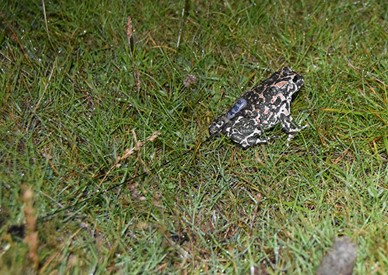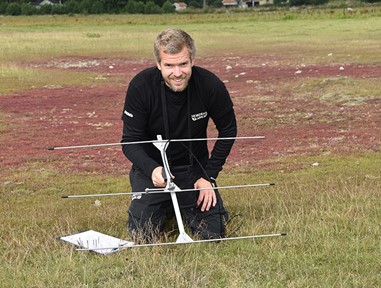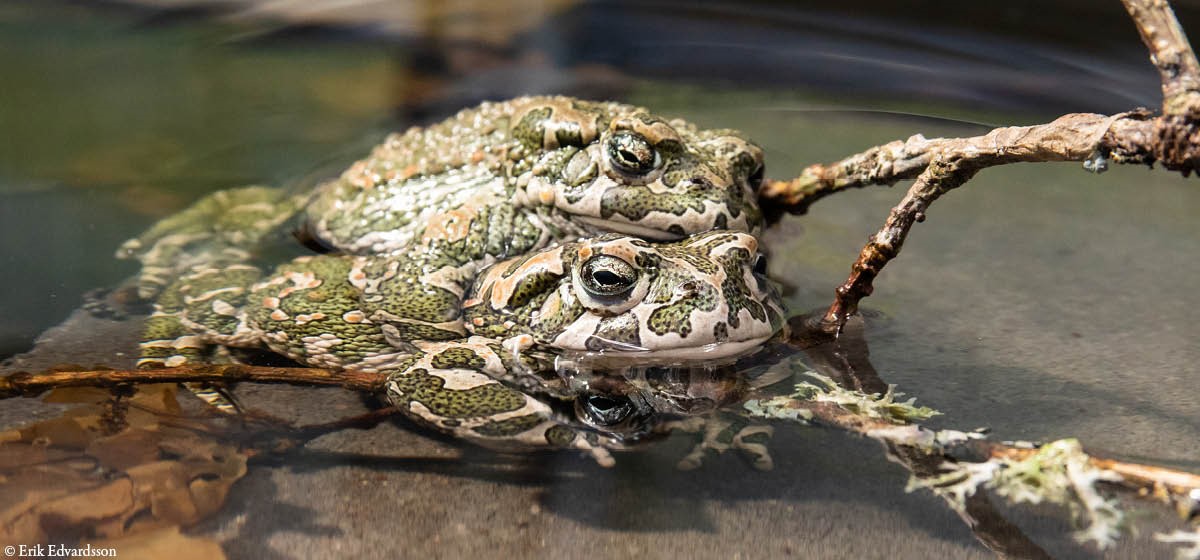Green toad conservation
The green toad was formerly common in coastal areas in southern and southeastern Sweden, but is now only found in a few and isolated places in Skåne and Blekinge, with very little opportunity for natural spread. The species is today considered Sweden's rarest and most endangered amphibian, and is classified on the Swedish red list as Vulnerable.
The species has declined steadily in Sweden throughout the 20th century, and the reasons are many. Its habitat has been destroyed to make way for forestry and agricultural land, and reduced grazing on coastal meadows has led to overgrowth. Small ponds have been filled in or drained, groundwater levels have fallen in several places, and water quality has deteriorated due to eutrophication.
The green toad was, 100–200 years ago, one of the most common amphibians on Öland, but by the 1990s it had likely disappeared entirely from the island. Thanks to restored wetlands and more than 300,000 released toads since 2009, the species has made a remarkable comeback and is now spreading to new areas on the island. Historically, the green toad also occurred on Gotland, but it likely disappeared from the island’s fauna in the mid-20th century.
What we do at Nordens Ark
For many years, Nordens Ark has been actively involved in the conservation of the green toad through breeding, rearing and release. In previous years, individuals have been released in Skåne, Blekinge, Öland and Gotland, and since 2009 efforts have focused primarily on Öland. In 2025, Nordens Ark and the County Administrative Board of Gotland began work to reintroduce the green toad to Gotland as well, through the release of tadpoles and adult individuals. All work is carried out in collaboration with the County Administrative Board of Kalmar, within the framework of Sweden’s action plan for threatened species.
Green toads are bred in Nordens Ark’s closed breeding facility, where they are kept entirely separate from other operations under strict biosecurity measures. This minimises the risk of introducing disease into the facility. Each year, tens of thousands of individuals are reared at Nordens Ark and later released into the wild. Releases include individuals of different ages, with tadpoles, recently transformed juveniles and adult toads all being released. By releasing toads at different life stages, we help to rebuild the missing generations, which may accelerate the re-establishment of the species.

Toad equipped with radio transmitter.
Before release, the toads are tested and certified free from the fungal disease chytridiomycosis and ranavirus, both of which are major causes of amphibian mortality worldwide. Releases are concentrated mainly at the southern tip of Öland, in a bird protection area near Högbyhamn on the island’s north-western side, and in southern Gotland. At release sites, overwintering habitats have been created to help the toads survive the winter, and restoration has also included the creation of new shallow breeding waters.
Kristofer Försäter from Nordens Ark searches for toads with radio telemetry.
News from the project – December 2025
During spring and early summer 2025, reports came in of large numbers of calling males at several geographically separate sites on Öland. These are encouraging signs that our work together with the County Administrative Board of Kalmar to re-establish a population of the green toad on Öland is yielding results. In early summer, a total of 275 adult toads, 1,000 yearlings and 50,000 tadpoles were released on the island.
In 2025, Nordens Ark and the County Administrative Board of Gotland also began the process of reintroducing the green toad to Gotland. During the summer, the first release was carried out, with more than 19,000 tadpoles released in southern Gotland.





